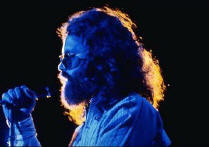This article was first
published on CLUAS in May 2003
The Demons of P?e-Lachaise
Mark Godfrey reflects on Jim Morrison after a visit to his grave in Paris...
P?e Lachaise is a vast cemetery like no other. Here lie the remains of
illustrious creators like Oscar Wilde, Edith Piaf, Fr?eric Chopin and Gertrude
Stein. Jim Morrison's death gave the cemetery its biggest draw
however. Every year the pilgrims come to Mecca. From all over the world they
come. The grave is marked out with signs. The security guards keep a bored
watch, interrupting a Canadian acoustic take on 'The End'. Morrison's own words
are etched in Greek: 'Excise Your Own Demons.' A crocodile-shoed crock of the
70s lights a cigarette and places it on the soil of the grave, there to stand
with pots of flowers, bouquets, roses, watches, candles, scraps of paper and
blotched ink. The graffiti is everywhere. The old rockers have come from
Florida, greasy and sore- eyed from sleeping in too many airports and train
stations.
 F?ix de Az? has called it the 'Rimbaud syndrome': some artists come to be
transformed into a figure of mythic proportions and ambitions. 'These are
artists with a convulsive temperament that swings abruptly between depression
and interspection to periods of huge genius' wrote Az?. Unpredictable, highly
strung, part antisocial, Jim Morrison took the syndrome to rock culture like no
one before him. He also brought the genre more original creativity than most of
its surviving figures.
F?ix de Az? has called it the 'Rimbaud syndrome': some artists come to be
transformed into a figure of mythic proportions and ambitions. 'These are
artists with a convulsive temperament that swings abruptly between depression
and interspection to periods of huge genius' wrote Az?. Unpredictable, highly
strung, part antisocial, Jim Morrison took the syndrome to rock culture like no
one before him. He also brought the genre more original creativity than most of
its surviving figures.
Born in Melbourne, Florida on the 8th of December 1943, Morrison registered as a
theatre and cinema student at the University of California in Los Angeles. His
US Navy admiral father dictated a future his son didn't want. Jim devoured
symbolist literature: Rimbaud, Baudelaire, Verlaine - the same writers who
excited Patti Smith. These scribes helped imbue in Morrison his social
conscience too. His other stimulation of a non-sexual nature was rhythm and
blues music, still a very black art form.
A pianist form Chicago named Ray Manzarek was the catalyst between Morrison and
musical success. The two met at a local club and were bound by more than a
shared bohemia. They took the name from William
Blake. 'There are things that are known, and things that are unknown, and
between them there are the doors.' Mystery, LSD, experimentation, cryptic poetry
were Morrison's media and the mix was typified in 'Break On Through to the Other
Side' and 'Light My Fire' from the band's first album 'The Doors', released in 1967.
Morrison, Manzarek, Robbie Krieger (guitars) and John Densmore on drums took the
language of rhythm and blues and meshed it with psychedelia and cabaret (hence
their take on Kurt Weill's 'Alabama Song'). Morrison in reality however was drawn
to music only in its ability to extend his poetic license further. His poetry
compilations are available in volumes like 'The Lords', 'The New Creatures' and
'The
Celebration of the Lizard'.
Someone who always took things to the limit, to extremes, Morrison couldn't do
anything other than be lewdly exhibitionist at concerts, clash with cops or
nourish an addiction to booze and other stimulants. Morrison had created a
persona: the quintessential tormented and irreverent artist.
On the 1st of March 1969 the Doors frontman was arrested at the Dinner Key
Auditorium in Miami. Morrison ended the show with an arrest for 'simulating
masturbation and oral sex on the audience' and was
slapped with a five hundred dollar fine and eight years penal servitude. He
never served the sentence: it was still being appealed two years later when he
died. The judge who sentenced him died this January, 2003.
A one way street took him to Paris in January 1971, to an apartment on Rue
Beaux-Arts, which he rented with girlfriend Pamela Courson. Morrison wanted to
distance himself from the music business and write
more poetry. More time was spent however in the bars and bistros of the area
than on artistic research. But then Morrison did often find his inspiration at
the bottom of a whiskey glass... Morrison went beyond
his usual extremes on a balmy third day in July 1971. Life ended with an
overdose of experimentation. He died in his bath of a heart-attack, brought on
by drugs and drink. Jim Morrison was 27, the same age as
Jimi Hendrix was when he died. Kurt Cobain, Janis Joplin and Rolling Stones
creative pillar Brian Jones died at that age too.
The world of rock lost one of its great agitators on the 3rd of July 1971. Jim
Morrison, the charismatic singer of the Doors was an idol dead, an addition to
the other epic victims of pop's pioneering age. Poet and singer of the countercultural
revolution who left a legacy of convulsive discs, Morrison's cult lives on and
the record companies still squeezes new albums from the old recordings.
'The only thing that interests me is rebellion, disorder, chaos and any
senseless activity' said Morrison. The rebellious, the disordered and the
chaotic are pale shadows over Jim Morrison's tombstone at P?e
Lachaise. Stronger is the sense of senselessness: the senselessness of a great
talent's death and the empty sorrow left in his place. His death may have been
preordained or inevitable. Morrison was too volatile a star to shine peacefully.
Morrison once described religion as a 'bunch of bullshit.' Yet in the searching
faces, the tears and the candles gathered about his tomb in P?e Lachaise, Jim
Morrison has become an alternative religion, his bible a collection of music
that never loses its relevance nor its appeal.
Mark Godfrey
